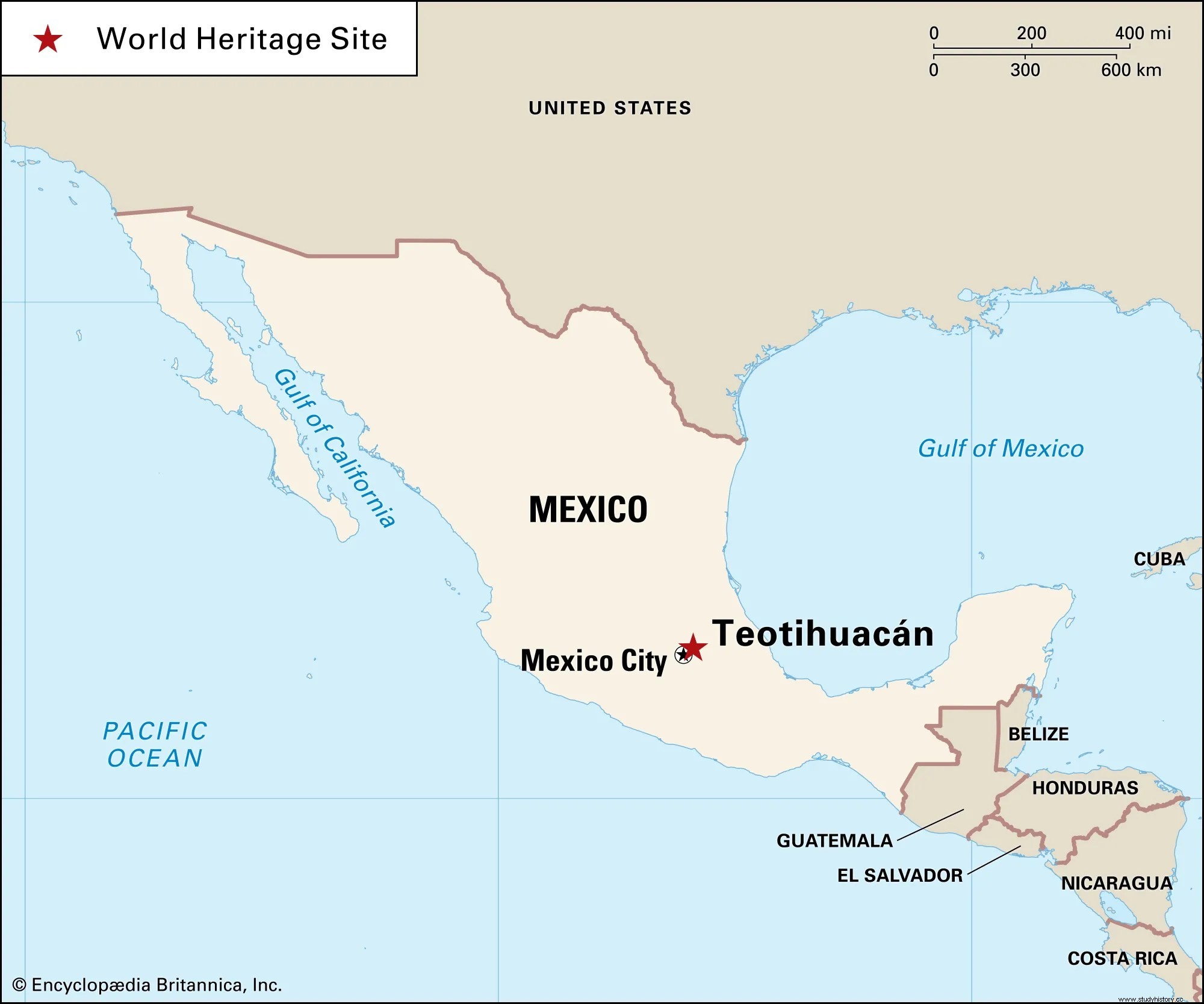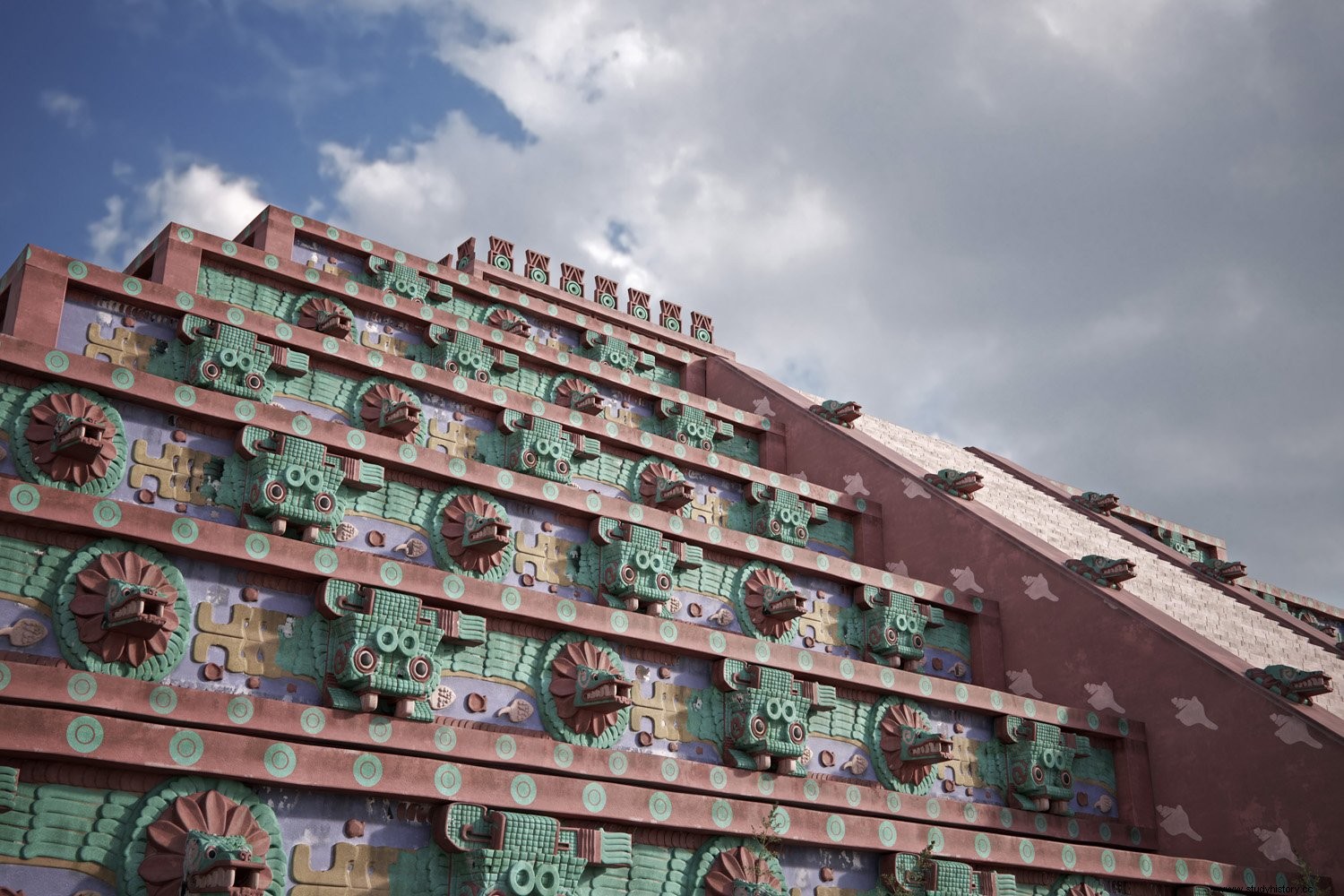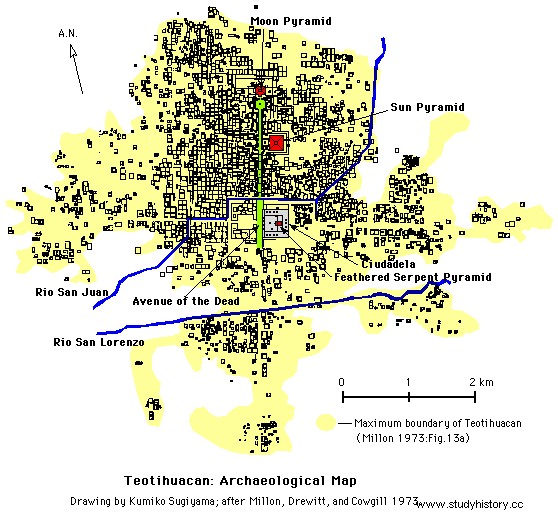Temple of the Feathered Serpent (Quetzalcóatl) in Teotihuacán - Background

The ancient site of Teotihuacán, located northeast of Mexico City, is home to many great monuments. It extends into a very organized grid layout. 2 perpendicular avenues, north-south and east-west, divide the city into quarters. At the north end of the north-south avenue is the pyramid of the moon.


Further down this avenue, the pyramid of the sun rises. Countless other monuments are scattered around these important places. For example, just south of the lunar pyramid stands a ring with much smaller but still significant temple pyramids. The whole scene is quite reminiscent of St. Peter's Basilica and the pillar arms that extend from it in the Vatican. In addition, beyond the towering monuments, many homes, workshops, markets and entire neighborhoods have since been uncovered in the old suburbs, or in the urban area itself, which is now known to have been much larger than previously thought. The 3 largest monuments in the whole place are the solar pyramids, the moon and the Quetzalcoatl temple (the feathered serpent).

The solar and lunar pyramids are the most impressive for tourists. Their monumental steps have been the subject of ancient urban planning, mystery, pseudo-history and other interests. However, their sloping faces are relatively simple, while their smaller neighbor, the Quetzalcóatl Temple, is much more decorated. This temple has a 4-step pyramid with a staircase in front. However, old builders added features much later. The back (east) of the pyramid temple shows many complex sculptures of animals and other symbols. This level of detail is not so much found in any of the other pyramids. Why was this third temple in particular made much more intricate?

To begin with, the features of the Quetzalcóatl temple in antiquity were probably very important. Ancient monuments very rarely showed random decoration. There was almost always a religious purpose behind everything that was laid on the surface of these important buildings. Fortunately, there are many scientific theories about the ancient purpose of the temple. As a result, we can better understand why the decoration of this temple was specially made.
Architectural design and decorations of the temple
Let us first examine the decorations of the Quetzalcóatl temple. The Pyramid Temple is in Talud-Tablero style, with sloping walls (Talud) and vertical platforms (Tablero).

This pattern forms the structure of many ancient Mesoamerican monuments across a variety of pre-Columbian cultures (Sugiyama 1989). There are also countless variations of this style across many different ancient Mesoamerican cultures. It is worth noting that to this day, researchers are still not sure which people (s) built or lived in Teotihuacán. We are also not sure what languages people spoke in the old city. However, there is evidence of ethnic neighborhoods between the different quarters. Therefore, it is possible that the Maya people and other better known people at least had a certain presence in this beautiful city. They believe that this city enjoyed waging war far and wide. Some skeletons found at Teotihuacán came from modern Guatemala!
It is also believed that Teotihuacán at one time conquered the great Mayan city of Tikal, forcing a ruler loyal to Teotihuacán. In any case, this city was very rich, and could afford to show it through the temple construction. Important religious patterns adorn both elements of this architectural style. In addition, the tablero decorations on the Quetzalcóatl temple show 2 different, alternating serpentine patterns (Sugiyama 1989).

The meaning of snake heads
Physical description
Second, let's break down the intricate designs found on the western surface of the temple. On one side, one of the head designs has a hose with a feather collar. It emerges from a carved hoop, behind which the rest of the body extends to one side. In the reconstruction below, this head is shown in red. On the other hand, interspersed with these "bodies" is the second head design, with a larger, more abstract representation of a snake. In the reconstruction below, this head is shown in green, and is more boxy in shape.
Over the years, archaeologists have wondered about the significance of the larger of the two head patterns. Both patterns are probably depictions of different deities, namely alligator-like cipactli beings, Xiuhcoatl and the feathered snake Quetzalcóatl (Sugiyama 2).

Furthermore, other theories include a dualistic interpretation of creation for the changing heads (Sugiyama 1989). It is possible that the changing heads remember the role that the god Quetzalcóatl played in a number of creation myths with a dualism theme. A theory that has gained recognition was independently conceived by both Sugiyama and Taube (Austin et al, 1991). It identifies the larger heads as ceremonial headdresses worn by elite priests during ritual observations dedicated to Quetzalcóatl (Sugiyama 1989).
Political and military significance of the snake heads
These abstract serpentine garments probably had connections to the wider use of the temple, including those of military and state crafts. Contrary to first impressions, Ciudadela, where the Quetzalcóatl Temple stands, was the center of Teotihuacán. The map below shows Ciudadela as the gray square in the middle. In the right center of this square shows a small red square Temple of the Feathered Serpent. North of Ciudadela you can also see the pyramids of the sun and moon in red.
An elite headquarters
This image helps to emphasize the importance of the original question. Why was the feathered snake pyramid much more decorated, when it was so much smaller? Why was this the ruling center of this ancient cosmopolitan policy? In addition, many magnificent palaces and ritual centers were once concentrated in this place (Taube 1992). It is possible that this palace witnessed a crossroads between devoted religion and practical warfare.


The physical reconstruction above shows the size of the plaza in Ciudadela. One would probably have entered it from the small temples on the west side of the main street (the foreground in the picture). It is also interesting to see that much of Mesoamerican architecture, across many cultures, used red and white as the two most important colors for decorating buildings.
The white was probably stucco, made of molten limestone. The amount of stucco they produced meant that they constantly had to burn large stoves day and night. It is also believed that this stucco contributed to soil erosion. This was probably the end of many advanced Mesoamerican cultures, such as the Mayans and the people of Teotihuacan. Towards the end of Teotihuacán there is also evidence of scorched rebellion, in which the common people burned the residences of the elite.
Sacrifice and Ciudadela
In any case, Ciudadela probably saw many uses in war and religion. Archaeologists excavated dozens of young male victims in the Ciudadela area. Many of them have objects that reveal their professions as soldiers (Taube 1992). Teotihuacán's militant nature was no secret at home or "abroad". The discovery of a mural north of Ciudadela connects the warlike nature of the city with the militant aspects of Quetzalcóatl. The mural depicts warriors wearing feathers with feathers (Sugiyama 1989).
Sugiyama also used this mural to propose a Quetzalcóatl-dedicated elite based in Ciudadela. Furthermore, their religious status would have been visually conveyed through the patterns of the serpent on the tableros of the temple.
Dualistic religious interpretations of serpent heads
Nevertheless, Sugimaya Coe's claims that the alternating serpent heads demonstrate dualistic religion. He argues that both tablero snake head patterns are depictions of the feathered snake. Consequently, he assigns the entire temple to one deity, Quetzalcóatl (Sugiyama 1989). However, there are other interpretations of duality that are not as easily rejected.
For example, Taube agrees that the abstract snake head symbolizes headgear. In contrast, he then claims that the headdresses depict the war serpent, or the god Xiuhcoatl, instead of the feathered serpent (Taube 1992). In this case, a dualism arises between the war and feathered serpents, or between Teotihuacán's military expansion and internal prosperity. Thus, the Temple of the Feathered Serpent was totally dedicated to war (Taube 1992).
Snakehead and human hierarchy
In fact, it is a different dualistic interpretation. This possibility moves away from cosmic religion. It emphasizes a duality between secular rule between Teotihuacan's king and priests (who may have worn these headdresses), and Quetzalcóatl. Together they are represented as peers on this earth who rule over ordinary people in Teotihuacán. This duet suggests that the universe cannot exist and flourish without the deity or elite of human priests. It is an example of the incorporation of religion as a way of supporting the temporal human hierarchy. Most importantly, the deity "chose" the priests to help maintain the universe. From all this, it is no wonder that the following Aztecs regarded Teotihuacán as "the home of the gods".
The pyramid as a temple of "time"
The Quetzalcóatl Temple undoubtedly helped the people of Teotihuacán maintain sacred relations with their world. Therefore, it is worth thinking more specifically about what the Temple of the Feathered Serpent meant in the vastness of Teotihuacán mythology. In ancient Nahua myth, Quetzalcóatl transfers the divine to the worldly. One of his greatest gifts was "time" (Austin et al, 1991). In some myths, Quetzalcóatl takes a goddess named Cipactli, often an alligator, and divides her into 2 (Austin et al, 1991).

Afterwards, in the cavity between her two halves, our world, the sky and the underworld are formed through several levels. Each level corresponds to 20-day months, with 18 in total) (Austin et al, 1991). The nature of this leveled cavity gave rise to divided, ordered, calendar time (Austin et al, 1991). Fray Gerónimo de Mendieta says that the calendar was Quetzalcóatl's Thought; the gods wanted to guide us (Austin et al, 1991).
In other words, the temple of Quetzalcóatl, as well as other Mesoamerican monuments to Quetzalcóatl, were temples today. Quetzalcóatl sends time from its divine source to its earthly recipients to distribute divinely assigned duties. These duties reflect those performed by the gods, including the rising and setting of the sun (Austin et al, 1991).
In fact, the young male victims are found in groupings of calendar numbers, including 18 in a northern pit. These figures correspond to the number of Quetzalcóatl headgear found on each side of the west staircase (Austin et al, 1991).
Time in the arrangement of sacrificial graves
Other archaeological finds support the interpretation of the Feathered Serpent Pyramid as having been dedicated to time. Additional graves flanking the 18 total 20, reminiscent of the days in each of the 18 months (Austin et al, 1991). Other objects also suggest devotion to Cipactli, whose body was the source of time. Necklaces found on the sacrificed victims are reminiscent of the original myth of Cipactli's split (Austin et al, 1991). In any case, it is also possible to interpret the headdress patterns as resembling alligators such as Cipactli.
This combination between Quetzalcóatl and Cipactli celebrates the beginning of the calendar season, and can be what the snake head garments convey. It is also what makes the whole temple a glorious physical (urban) model of the universe as the ancients knew it.
the conclusion
Review of theories
Ergo, we have reviewed many different theories about the interpretation of the snake head patterns in the Temple of the Feathered Serpent. Thanks to them, we now better understand that this structure was unparalleled in Teotihuacán's religion and political landscape. Many maps of Teotihuacán often start in the north with the lunar pyramid. They then follow the main avenue north-south down to Ciudadela. This often misleads viewers into believing that the massive solar pyramid was the true center of the old city.
However, detailed studies of the Pyramid of the Feathered Serpent and Ciudadela disprove the falsity of this view. After studying the religious and political significance of the snakehead patterns on the temple sides, we learn about the central significance of this monument above all others. But we are not only told that Ciudadela was the more likely political and religious center of the city. We also think of this in light of the fact that archaeologists, thanks to excavations that led to the present, uncovered much more of Teotihuacán.
Revisiting our thoughts on Teotihuacán
This places Ciudadela in the geographical center of a much larger city than ever before imagined. It was deliberately planned to stand there at a time when space, time and faith matched each other as closely as possible. As for Teotihuacán, this resulted in a marvel of urban planning that competes with everything in the modern old world, and continues to amaze people to this day.
We can imagine the elite priests in Ciudadela wearing headdresses with the gods. They would have performed military rituals that involved dozens of sacrifices on top of a temple representing war and the birth of time. In short, there should really be no doubt as to why this smaller temple needed some decoration.
Works Cited
Taube, Karl. "The temple of Quetzalcoatl and the cult of holy war at Teotihuacan". The
University of Chicago Press, No. 21, 1992, pp. 53-87.
López Austin, Alfredo; López Luján, Leonardo; Sugiyama, Saburo. "The temple to
Quetzalcoatl at Teotihuacan - Its Possible Ideological Significance ". Cambridge
University Press, vol. 2, no. 1, 1991, pp. 93-105.
Sugiyama, Saburo. "Iconographic interpretation of the temple of Quetzalcoatl at Teotihuacan".
Mexico, vol. 11, no. 4, 1989, pp. 68-74.
